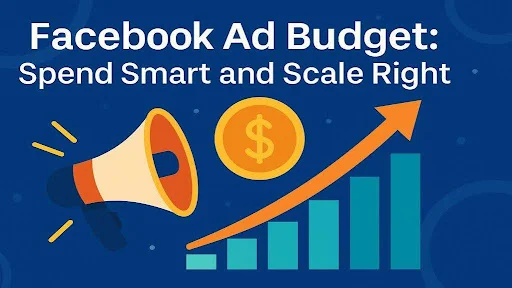Optimizing your Facebook ad budget isn’t so much about cost control—it’s about growth. Being one of the most coveted places to place targeted online ads, how you allocate and prioritize your spend will be the difference between your success and failure.
This guide walks you through a performance-based budgeting system that provides you with a framework that enables you to have successful and scalable Facebook ad campaigns.
Choosing the Budget Type

Facebook provides ‘daily budget’ and ‘lifetime budget’ options.
- A daily Facebook ad budget provides a definite expenditure day in and day out, best for ongoing campaigns where you need control.
- Lifetime budget enables Facebook to use up the budget over the campaign period, convenient for short promotional seasons or utilizing peak times.
Both options can work, but the right choice depends on your brand’s goals, timeline, and level of flexibility.
Align the Budget with Business Objectives

Effective budgeting begins with determining your campaign objective—conversion, traffic, or lead generation. And reverse-engineer your numbers:
- Estimate an appropriate cost per result.
- Decide how many results will make the campaign successful.
- Use those numbers to determine your required budget.
For example, a 200 sign-up target and a $3 spend target per sign-up bring a working budget of $600. This method ensures that every dollar is utilized, avoiding wastage of expenditures and maximizing ROI over the long term.
If you already have expanded campaigns and want to keep expanding, you can make your planning and execution easier with the assistance of a data-driven service provider.
Budget Distribution Across the Funnel

A successful Facebook campaign won’t revolve around a single message or single audience. Successful marketers invest throughout the marketing funnel:
- Funnel top (awareness): Broad targeting for new attention capture
- Middle funnel (consideration): Converting the interested ones into converters
- Funnel bottom (conversion): Advertising to warm leads or repeat visitors
Dividing your total ad budget among these stages gives you the option to monitor, hone, and tailor your message. Facebook Campaign Budget Optimization (CBO) can also assist by dynamically spending on actively running ad sets, maximizing performance without constant manual optimization.
Measuring Results and Making Adjustments

Once you have put advertisements on the internet, that is not the end. What follows is equally crucial: tracking and optimizing. Some of the most critical things to track are
- Click-Through Rate (CTR): Tracks how well your ad creative is performing.
- Cost Per Click (CPC): Measures cost-effectiveness in drawing traffic.
- Conversion Rate: It measures the quality of the post-click experience.
Facebook has a break-in period too; let it run for a while before making drastic changes. Once the performance has stabilized, experiment with new ad features, tighten up targeting, or gradually up the budget to drive results. Scaling must follow success, not precede it. Steady growth preserves optimization and provides room for growth.
Key Takeaways

In order to be consistent in your performance, avoid the following errors:
- Scaling too aggressively: Sudden scaling impacts campaign learning by resetting it and lowering efficiency.
- Overbroad targeting: Overbroad targeting produces low-quality impressions and wasted advertising spend.
- Low creative rotation: Repetition is boring. Switch copy and images often. Ignoring page experience: Even excellent ads are undermined by a bad landing page.
Forward-looking and fact-based requires that your budget be based on actual performance, not projections.
Long-Term Budget Plan
While single campaigns are undoubtedly worthwhile, the most enduring and longest-lasting impacts come from budgeting as part of an extensive system of expansion.
Your budget has to balance short-term victories with long-term activity. Consider where Facebook ads fall in your customers’ end-to-end journey: retargeting blog readers, re-engaging former customers, or driving leads from another source.
Planning at this higher level not only increases the ROI of a campaign but also achieves more stable results over the longer term.
Conclusion
It is not merely a matter of allocating budget numbers. Facebook ad budgeting is a matter of resource allocation in the most optimal manner to achieve business success. From choosing the best budgeting model to charting out long-term strategy, all the decisions are towards the betterment of business performance. Monitor your data, keep refining with incremental steps, and have a clear intent for each campaign.
FAQs
What is an appropriate initial daily budget to use with Facebook advertising?
Starting at $10–20 per day allows you to collect information and organize but stay within budget.
How do I know whether I should have a daily or a lifetime budget?
Daily for continuous campaigns that need continuous exposure; lifetime for promotion campaigns involving time limitations.
Can I modify budgets during a campaign?
Yes, but do it gradually so that Facebook’s optimization algorithm is not affected.
How long should I wait before taking the performance measurement?
Run your ads for 3–5 days minimum to allow Facebook’s learning period to complete before making significant changes.
How do you determine when to raise the budget?
If the cost per result is low and fixed, then it is possible to expand the budget in small increments to achieve more cost-effectively.


